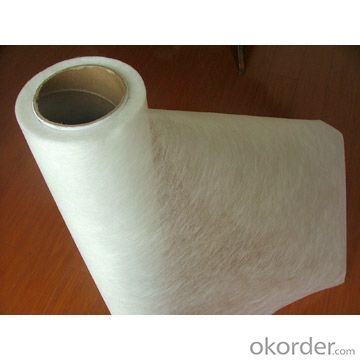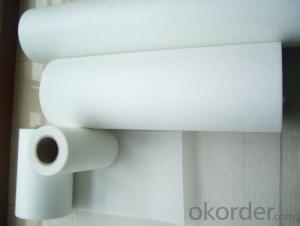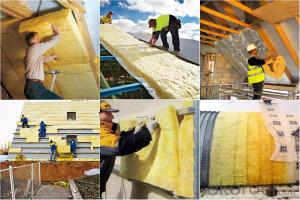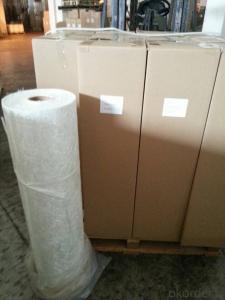E Glass Surface Tissue Mat For FRP Pattern Technology
- Loading Port:
- Qingdao
- Payment Terms:
- TT OR LC
- Min Order Qty:
- 144000 m²
- Supply Capability:
- 1440000 m²/month
OKorder Service Pledge
OKorder Financial Service
You Might Also Like
Surfacing Tissue mainly used in the surface layers of FRP products. It features even Fiber distribution, soft feel, level and smooth fiber surface, less glue content, quick resin soak and good pattern fitness. It can improve the product surface property on corrosion resistance, compressive strength, seepage resistance, and longer service life. It is also suitable for spraying; pattern pressing and other FRP pattern technology.
2.Characteristics
Fast breakdown in styrene
Fiber dispersed evenly
Low binder content
Superior acid corrosion resistance
3.Specifications
Item | Unit | Specification |
Area Weight | g/m2 | 30+/-3 |
Binder Content | % | 6-9 |
Tensile Strength MD | N/125px | ≥35 |
Soaking time | S | ≤10 |
Moisture content | % | ≤0.5 |
Width length
| mm
| 1270
|
Roll Diameter
| m | 300
|
Paper Core Internal Dia | mm | 76 |
Special specification can be produce according to customer requirements.

4.FAQ
a.Pacage
Each Surface Tissue is wound onto a paper tube which has an inside diameter of 76mm and the mat roll has a diameter of 330mm. The mat roll is wrapped up with plastic film,and then packed in a cardboard box or wrapped up with kraft paper. The rolls can be vertically or horizontally placed. For transportation, the rolls can be loaded into a cantainer directly or on pallets.
b.Product storage:
Unless otherwise specified, Chopped Strand Mat should be stored in a dry, cool and rain-proof area. It is recommended that the room temperature and humidity should be always maintained at 15℃~35℃ and 50%~75% respectively.
- Q:How is fiberglass mat tissue used in the production of windshields?
- The unique properties and functions of fiberglass mat tissue make it a crucial component in windshield production. To strengthen and increase the durability of the glass, manufacturers use fiberglass mat tissue as a reinforcement material. In the manufacturing process, a layer of fiberglass mat tissue is inserted between two layers of glass to create a laminated structure. This layer acts as a barrier, preventing the glass from shattering upon impact and holding it together for the safety of the vehicle occupants. By serving as a reinforcing material, fiberglass mat tissue improves the mechanical properties of the windshield. It enhances the impact resistance, reducing the likelihood of cracks or chips caused by stones, debris, or other objects. This reinforcement also provides structural integrity, allowing the windshield to withstand extreme weather conditions and vibrations without affecting its functionality. Moreover, fiberglass mat tissue aids in reducing noise transmission and vibrations. Its sound-damping properties contribute to a quieter and more comfortable driving experience by minimizing external noise from entering the vehicle cabin. Additionally, the use of fiberglass mat tissue enables the production of curved windshields. The material's flexibility allows it to conform to different shapes and contours, enabling manufacturers to create windshields with customized designs and improved aerodynamics. In conclusion, fiberglass mat tissue plays a vital role in windshield production. Its reinforcement properties enhance the strength and impact resistance of the glass, ensuring the safety of vehicle occupants. It also contributes to a quieter driving experience and enables the production of curved windshields with improved aerodynamics.
- Q:What are the typical dimensions and roll sizes of fiberglass mat tissue?
- Fiberglass mat tissue dimensions and roll sizes may vary depending on the product and manufacturer. Typically, rolls of fiberglass mat tissue come in widths ranging from 1 to 6 feet and lengths ranging from 100 to 1000 feet. The thickness of the tissue can range from 0.5 to 1.5 millimeters. Certain manufacturers may provide tailored sizes and lengths to meet specific project needs. To obtain the precise dimensions and roll sizes of fiberglass mat tissue, it is advisable to consult the manufacturer or supplier.
- Q:How is fiberglass mat tissue used in the construction industry?
- Various applications in the construction industry make fiberglass mat tissue widely used. This material consists of thin strands of glass fibers bonded together with a resin, providing properties suitable for construction purposes. Roofing materials often utilize fiberglass mat tissue as a reinforcement layer in shingles or sheets. It enhances the roof's strength and durability, making it more resistant to weather elements like wind, rain, and hail. It also prevents cracking and splitting, extending the lifespan of the roofing material. Fiberglass mat tissue has another application in the construction industry, specifically in the production of composite materials. It serves as a reinforcement layer in composite panels and boards, enhancing their strength and stiffness. Its lightweight nature makes it ideal for building materials that require both strength and reduced weight. In the construction of walls and ceilings, fiberglass mat tissue can be applied between the gypsum board and insulation material. This provides additional strength and impact resistance, preventing cracks and damage to the building's structure. Additionally, fiberglass mat tissue finds use in the manufacturing of pipes and tanks. It reinforces fiberglass-reinforced plastic (FRP) pipes and tanks, adding strength and rigidity. This makes it suitable for various industrial applications, including chemical processing, wastewater treatment, and the oil and gas industries. In summary, fiberglass mat tissue is widely used in the construction industry due to its strength, durability, and lightweight properties. It is applied in roofing materials, composite panels, walls, ceilings, pipes, and tanks, among other applications. Construction professionals prefer it for its versatility and ability to enhance the structural integrity of various building components.
- Q:How is fiberglass mat tissue used in the production of printed circuit boards?
- Fiberglass mat tissue is a commonly utilized reinforcement material in the production of printed circuit boards (PCBs). PCBs, consisting of copper layers, insulating materials, and fiberglass, are typically made in this way. The purpose of the fiberglass mat tissue is to provide structural support and mechanical strength to the PCB. Throughout the manufacturing process, the fiberglass mat tissue is saturated with epoxy resin, which forms a laminate material. This laminate is then combined with copper foils, serving as conductive pathways for the electrical signals on the PCB. The role of the fiberglass mat tissue in the performance and reliability of the PCB is crucial. It establishes a firm foundation for the copper layers, preventing delamination or warping due to mechanical stress or temperature fluctuations. Furthermore, it helps maintain the PCB's dimensional stability, ensuring its flatness and rigidity. Additionally, the fiberglass mat tissue enhances the PCB's resistance to heat and moisture. The epoxy resin used in the laminate provides excellent insulation properties, shielding the copper conductors from short circuits and electrical leakage. Furthermore, the fiberglass mat tissue acts as a barrier against moisture absorption, safeguarding the PCB from damage or malfunctions. In conclusion, fiberglass mat tissue is an indispensable element in the production of printed circuit boards. It offers structural support, improves mechanical strength, ensures dimensional stability, and enhances resistance to heat and moisture. Ultimately, the use of fiberglass mat tissue contributes to the overall reliability and performance of PCBs in various electronic devices.
- Q:Can fiberglass mat tissue be used for reinforcing concrete?
- Indeed, reinforcing concrete is possible with the utilization of fiberglass mat tissue. This lightweight and flexible material is frequently employed in construction endeavors to augment the sturdiness and endurance of concrete structures. By embedding it within the concrete, additional reinforcement is provided, which aids in averting the formation of cracks over time. Typically crafted from top-notch glass fibers that are interwoven to form a robust and steady substance, fiberglass mat tissue showcases exceptional tensile strength and corrosion resistance, rendering it an optimal selection for enhancing the performance of concrete. Whether employed in sidewalks, driveways, or other concrete formations, the presence of fiberglass mat tissue can substantially heighten the potency and lifespan of the concrete in question.
- Q:Can fiberglass mat tissue be used for repairing automotive parts?
- Certainly, automotive parts can be repaired using fiberglass mat tissue. This versatile material is commonly employed to reinforce and repair various surfaces, including automotive components. It proves particularly valuable when restoring fiberglass parts such as car bodies and panels. Fiberglass mat tissue possesses a thin and flexible composition, comprised of randomly arranged fiberglass strands. This design enables easy molding and shaping to match the contours of the damaged automotive part. Typically, the mat tissue is applied alongside a resin like polyester or epoxy, which binds the fibers together, yielding a robust and enduring repair. When utilized for automotive repairs, fiberglass mat tissue offers numerous advantages. Firstly, its lightweight nature is crucial for maintaining the overall weight and balance of the vehicle. Furthermore, it exhibits resistance to corrosion and can withstand exposure to diverse weather conditions, rendering it suitable for all automotive repair applications. Moreover, fiberglass mat tissue is renowned for its high tensile strength, enabling it to endure the stresses and strains encountered during normal use of automotive parts. As a result, it becomes an ideal choice for fixing damaged or weakened areas, such as cracks, holes, or dents in car bodies or panels. In conclusion, fiberglass mat tissue is a highly effective option for repairing automotive parts, especially those constructed from fiberglass. Its versatility, lightweight composition, corrosion resistance, and high tensile strength make it an exceptional choice for restoring the structural integrity and appearance of damaged automotive components.
- Q:Can fiberglass mat tissue be used for making decorative panels?
- Fiberglass mat tissue is a versatile material commonly used in construction and manufacturing industries. It consists of randomly oriented glass fibers bonded together with a binder, resulting in a strong and durable product suitable for various applications. For decorative panels, fiberglass mat tissue is an excellent option. It can be molded into different shapes and sizes, allowing for intricate and unique designs. The material is lightweight and easy to handle and install. Additionally, it has excellent dimensional stability, ensuring it won't warp or deform over time. Moreover, fiberglass mat tissue is highly resistant to moisture, chemicals, and UV radiation, making it suitable for both indoor and outdoor use. It can withstand harsh weather conditions without rotting or decaying. This durability ensures that decorative panels made from fiberglass mat tissue will maintain their appearance and functionality for an extended period. When it comes to finishing, fiberglass mat tissue can be easily painted or coated to achieve the desired aesthetic. It can also be laminated with other materials, such as wood veneer or decorative films, to enhance its visual appeal. This flexibility offers endless design possibilities, making fiberglass mat tissue an excellent choice for creating decorative panels. In conclusion, fiberglass mat tissue is a reliable material for making decorative panels. Its strength, durability, and versatility make it suitable for various indoor and outdoor applications. Whether you want to create unique designs or enhance the aesthetics of a space, fiberglass mat tissue provides the necessary qualities to achieve your desired outcome.
- Q:Can fiberglass mat tissue be used for insulation boards?
- Yes, fiberglass mat tissue can be used for insulation boards. It is frequently utilized in insulation boards due to its excellent thermal and acoustic insulation properties. The fiberglass mat tissue helps to enhance the insulation capabilities of the boards, making them more energy-efficient and effective in reducing heat transfer and sound transmission.
- Q:Does fiberglass mat tissue provide good acoustical performance?
- Good acoustical performance is provided by fiberglass mat tissue. This material, composed of fine glass fibers, effectively absorbs sound waves and reduces echo and reverberation in a space. It possesses outstanding sound absorption properties, making it suitable for use in construction, automotive, and aerospace industries. The ability of fiberglass mat tissue to dampen sound and enhance acoustics makes it a favored option for soundproofing walls, ceilings, and floors in buildings. Moreover, its lightweight nature and ease of installation further contribute to its appeal for acoustical applications.
- Q:Can fiberglass mat tissue be used for making lightweight flooring?
- Yes, fiberglass mat tissue can be used for making lightweight flooring. It is a versatile material that offers excellent strength and durability while being lightweight, making it a suitable choice for flooring applications where weight reduction is desired.
1. Manufacturer Overview |
|
|---|---|
| Location | |
| Year Established | |
| Annual Output Value | |
| Main Markets | |
| Company Certifications | |
2. Manufacturer Certificates |
|
|---|---|
| a) Certification Name | |
| Range | |
| Reference | |
| Validity Period | |
3. Manufacturer Capability |
|
|---|---|
| a)Trade Capacity | |
| Nearest Port | |
| Export Percentage | |
| No.of Employees in Trade Department | |
| Language Spoken: | |
| b)Factory Information | |
| Factory Size: | |
| No. of Production Lines | |
| Contract Manufacturing | |
| Product Price Range | |
Send your message to us
E Glass Surface Tissue Mat For FRP Pattern Technology
- Loading Port:
- Qingdao
- Payment Terms:
- TT OR LC
- Min Order Qty:
- 144000 m²
- Supply Capability:
- 1440000 m²/month
OKorder Service Pledge
OKorder Financial Service
Similar products
New products
Hot products
Hot Searches
Related keywords





























